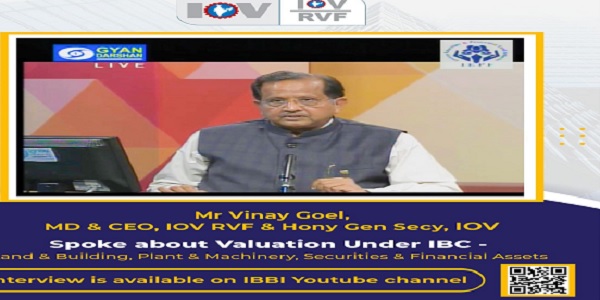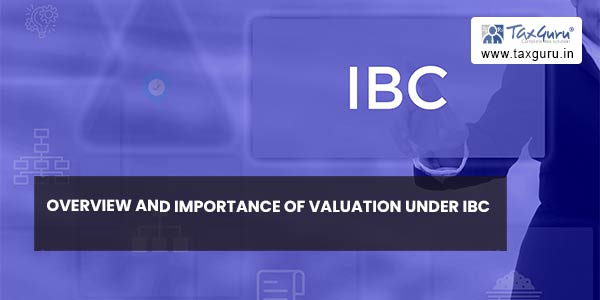Journey of valuation as profession began with Government acts such as Rent Control and later for the purposes of Income Tax. Beginning of registration as valuer under sec-34B of wealth tax act, saw a major shift in the profession towards it being institutionalized. Consequently, the profession started finding its place in the financial sector where it achieved a pivotal role for the debtors and creditors, both.
Prior to the Insolvency & Bankruptcy Code, Debt recovery has always been an area of concern for the Financial Institutions. Several methods and processes were adopted, but conceptually it revolved around the recovery alone. With the introduction of Debts Recovery Tribunals (DRT), a few restructuring procedures were applied for reducing the already stressed sectors to keep them going on. But the problem remained as more and more vital projects went on the way to become Non-Performing Assets (NPAs), resulting in the closure. Ultimately, the closures led to increase burden on economic conditions of not only the employees of those ventures but affected economic situation of the country as a whole.
Initially, the government had also framed the SARFAESI Act 2002, which aimed to recover the NPAs of the banks and Financial Institutions. The act aims to shut down the unit or company and very rarely worked towards refabricating it. Though it did not work towards timely recovery of the defaulted assets which falls as a strain in the Indian credit system.
Keeping in mind, the strain on the market and society, to improve the business environment by alleviating distressed credit market, the Modi Government introduced the Insolvency and Bankruptcy Bill in 2015, which get notified as Code in 2016. The IBC repealed the Presidency Towns Insolvency Act, 1920 Act, 1993 and Sick Industrial Companies (Special Provisions) Repeal Act, 2003, among others to combine and alter a solitary statute. The main aim of the IBC 2016 is to remove the considerable delay, red tapism, years of cumbersome litigations in resolution of stressed assets.
The primary objectives bring out the following intentions to be achieved by IBC
– Resolution/liquidation in a time-bound manner
– Maximisation of value of assets of corporate persons under insolvency
– To promote entrepreneurship
– Availability of credit
– Balance the interest of all the stakeholders
Out of these five objectives, the first objective is indirectly related and the rest are directly related to the Valuation of assets. This proves that valuation is the critical factor in achieving the objectives of the IBC in resolution and liquidation of assets. IBC has classified the valuation under following three asset classes: –
1. Land and Building Valuation – A land valuation can be described as the technique by which the valuation of the land is ascertained.
2. Plant and Machinery Valuation – It refers to finding the market value of all plant and machinery assets used in manufacturing and distributing goods and services by a business.
3. Securities or Financial Assets Valuation –It estimates and determines the appropriate interest rate or interest rates of the expected cash flows. It drives the securities market value including liquidity, demand, and supply of similar instruments, stock market rates of similar securities, etc.
The role and significance of valuation of assets of different kinds both in the regulatory and non-regulatory spheres have also made the value conclusions arrived by the valuers very crucial for the stakeholders.
IBC also provides for corporate insolvency resolution process (CIRP) and liquidation process for all entities. CIRP and Liquidation processes are dependent on not only an appropriate valuation for a defined purpose but also should stand the test of legal scrutiny in case any of the stakeholders including committee of creditors, insolvency professionals, financial creditors, operational creditors and anyone else whose interests could be directly or indirectly affected by the valuation, dispute the same in any or all of the adjudication proceedings under the IBC 2016.
With effect from 1st February 2019, every valuation required under the Insolvency & Bankruptcy Code, 2016 (“Code”) or any of the regulations made there under is required to be conducted by a ‘Registered Valuer’ registered for the respective asset class, that is, a valuer registered with the IBBI under the said Rules. No insolvency professional shall appoint a person other than a Registered Valuer to conduct any valuation under the Code or any of the regulations made there under.

The Registered Valuer means a person registered with the Authority (IBBI) as a Valuer, in accordance with the provisions of the Companies (Registered Valuers and Valuation) Rules, 2017. A Registered Valuer while performing its Assignment shall adhere to the various Statutory cum Regulatory Compliances such as:
1. Compliance of the provisions of the Companies Act, 2013 and Companies (Registered Valuers and Valuation) Rules, 2017
2. Compliance of the provisions of the Insolvency and Bankruptcy Code, 2016
3. Compliance of Code of Conduct of the concerned Registered Valuers Organisation of which he is a member
4. Compliance of Bye-Laws and Internal Regulations of the Registered Valuers Organisation of which he is a member
5. Compliance of Valuation Standards- i.e. Internationally Accepted Valuation Standards or ICAI Valuation Standards 2018
6. Compliance of Guidelines/Circulars/Notifications issued by IBBI from time to time.
7. Compliance of the provisions of the Law under which the Assignment has been accepted such as SEBI, Income Tax Act, 1961, RBI, IBC etc.
To enhance the competency of the valuers, Registered Valuer Organizations (RVOs) have been entrusted with the following responsibilities by IBBI:
1. To ensure that the aims and principles of ethical standards, such as integrity, objectivity, truthfulness and avoidance of conflicts of interest are followed by the Valuers in good spirit and in the interest of the Fair Valuation.
2. Conduct educational courses and practical training of 50 hrs. for individuals who possess the qualifications and experience as specified in the Rules, in accordance with syllabus determined by the authority to test their professional knowledge, skills values and ethics in respect of valuation.
3. Conduct training for the Valuer Members before issuing Certificate of Practice (COP).
4. Monitor the activities of its Valuer members, Redressal of Grievances, Disciplinary actions.
5. By creating awareness amongst the Registered Valuers for their responsibilities and accountability for the specific assignments being carried by them through various interactive sessions, seminars, workshops to be conducted under Continuing Education Programs (CEP).
6. By scrutinising the valuation reports of the Registered Valuers and pay random visits to the Registered Valuers to understand and improve the procedure being followed by them for carrying out the Valuation Assignments.
7. By creating awareness on modalities of getting the valuation assignments through CEPs.

As we move towards the full-fledged and comprehensive regulation in the form of a Valuers Act in the near future, the profession of valuation will also occupy a unique possession in the economic and financial spheres.
Before concluding, we should remember that assessment is the first & most critical tool in crafting valuation. The need for appropriateness, transparency and consistency in valuation of assets is felt more than ever before by the stakeholders. The valuation practitioners of different classes of assets must gear-up to meet the professional demands of this fast transformation. They can achieve these by upscaling their professional skills, competency, simultaneously meeting the regulatory obligations.
Apart from being qualified, a Valuer is required to develop the skills in crafting a Valuation opinion. Hence, all valuers need to ensure the following essentials while doing valuation and issuing valuation report:
1) Scope and Purpose of Valuation as defined to the Registered Valuer;
2) Basis of Valuation;
3) Selection of appropriate Valuation Standards e.g. IVSC;
4) Selection of appropriate approach i.e. a. Market Approach, Income Approach, Cost Approach.
5) Nature and Source of information used by the Registered Valuers while conducting inspection and Valuation;
6) Premise of valuation: Highest and Best Use, Orderly Liquidation, Current Use/Existing Use, Forced Liquidation (deployment of assets) etc.
7) Departures and Deviations occurred from the material documents provided and actual inspection of the site.
In order to establish the exclusive demand for a profession, strong foundation of academic pursuit coupled with self-regulation are required to be in place. Therefore, to meet the academic requirements and for building capacities, continuous participation in professional educational development programs plays an important role.





